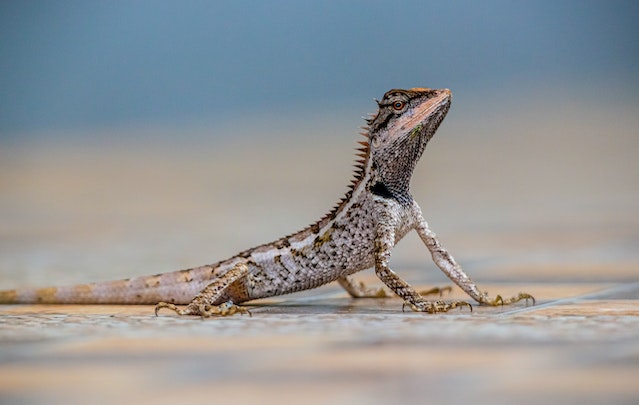
Why are some animals cold-blooded? It lets them go for longer without eating, which means they can survive in more inhospitable areas.
There are three types of animals: warm-blooded, cold-blooded, and those in between. Warm-blooded animals are called endotherms and they are able to maintain their body temperature by using their metabolism. We are endotherms. All of our cells do different things, but they all need energy to perform chemical reactions. When they perform the chemical reactions, they produce heat as a byproduct. We use our fat, our skin, and our clothes to retain as much of our heat as we can. The cells in our bodies need to be at a certain temperature to be able to work. If they lose too much heat and grow too cold to perform, we are able to speed up our metabolism to generate more heat. Our bodies are able to stay at a perfect temperature (unless something happens) without us having to do anything consciously.
Ectotherms also lose heat when they perform chemical reactions, but they are unable to keep this heat. They become the same temperature as their surroundings. However, they need heat to be able to perform chemical reactions and basically move, which is why many cold-blooded animals sun themselves before doing anything. Although, cold-blooded is actually not completely correct because these animals are the same temperature as their environment. If a fish is swimming in water that is 10 °C, the fish will have a body temperature of 10 °C, and if the water is 30 °C, the fish will have a body temperature of 30 °C, which is not exactly cold.
There are also some animals that are in between the two and they are called heterotherms. Bees are basically cold-blooded, but they can heat themselves up by flapping their wings fast, which pumps their wing muscles producing heat. They do this before they takeoff.
So, what advantages are there to being cold-blooded? Why would an animal evolve to be cold-blooded? It seems as though all the advantages are with the warm-blooded animals because they can use their muscles whenever they want, without needing to warm themselves up first. They can run away from predators at a moment’s notice, and they can be predators getting ready to pounce on prey. Well, there are two advantages.
The first is that cold-blooded animals don’t need to eat much. It takes a lot of energy to keep a warm-blooded animal at its ideal temperature. We are not very efficient, and we lose 75% of all the energy we take in through heat loss. We have an efficiency of 25%, which is better than a car, but it still means we need to take in a lot of energy to be able to maintain our body heat. Cold-blooded animals don’t need to do this. Cold-blooded animals have a much slower metabolism than warm-blooded animals, which means they don’t need to eat a lot or very often. If you have two warm-blooded and cold-blooded animals of equal size, the warm-blooded animal will need 30 times more energy a day to maintain its body temperature and survive. Cold-blooded animals don’t need anywhere near as much energy. An adult python, for example, will eat about once every two weeks. A crocodile will eat about once a week. However, both of these animals can go for long periods of time without eating. A python can survive six months with no food and a large crocodile can survive over a year. This ability means they can live in areas where food is scarcer. They don’t need to worry as much as a warm-blooded animal would have to.
There are obviously several disadvantages to being cold-blooded. One of them is that the animals can’t suddenly spring into action in the same way that a warm-blooded animal can. They need warming up first. That means they aren’t able to escape predators in the early hours of the day when it is colder. A lot of cold-blooded animals have elaborate camouflage to keep them hidden.
Another disadvantage is that they don’t do well if the temperature drops too much. All cells can only perform chemical processes in a certain temperature range. If the external temperature drops too low, a warm-blooded animal can produce heat and keep their metabolism going, but a cold-blooded animal cannot, and they shut down. Cold-blooded animals can freeze.
Cold-blooded animals are also unable to produce a fever if they have a bacterial or viral infection. We use a fever to kill the infection, but cold-blooded animals cannot do that. Research has shown that cold-blooded animals that are infected with a virus seek out very hot areas to try and raise their body temperature enough to kill the infection. This can work, but it is not as reliable as our fever mechanism.
The question “why are some animals cold-blooded?” is actually backwards. It is most likely that all animals started out as cold-blooded and warm-blooded animals evolved from them. The advantages of being warm-blooded far outweigh the energy requirement that is needed to produce our heat. The ability to produce a fever to fight off infections might have been the single biggest reason why warm-blooded animals evolved. And this is what I learned today.
Sources
https://www.unm.edu/~lkravitz/Article%20folder/thermoregulation.html
https://www.sciencedaily.com/releases/2019/06/190604172659.htm
https://journeynorth.org/tm/monarch/ColdBlooded.html
https://zooatlanta.org/cold-blooded-whats-it-mean

Pingback: How big and how small can a mammal be? - I Learned This Today